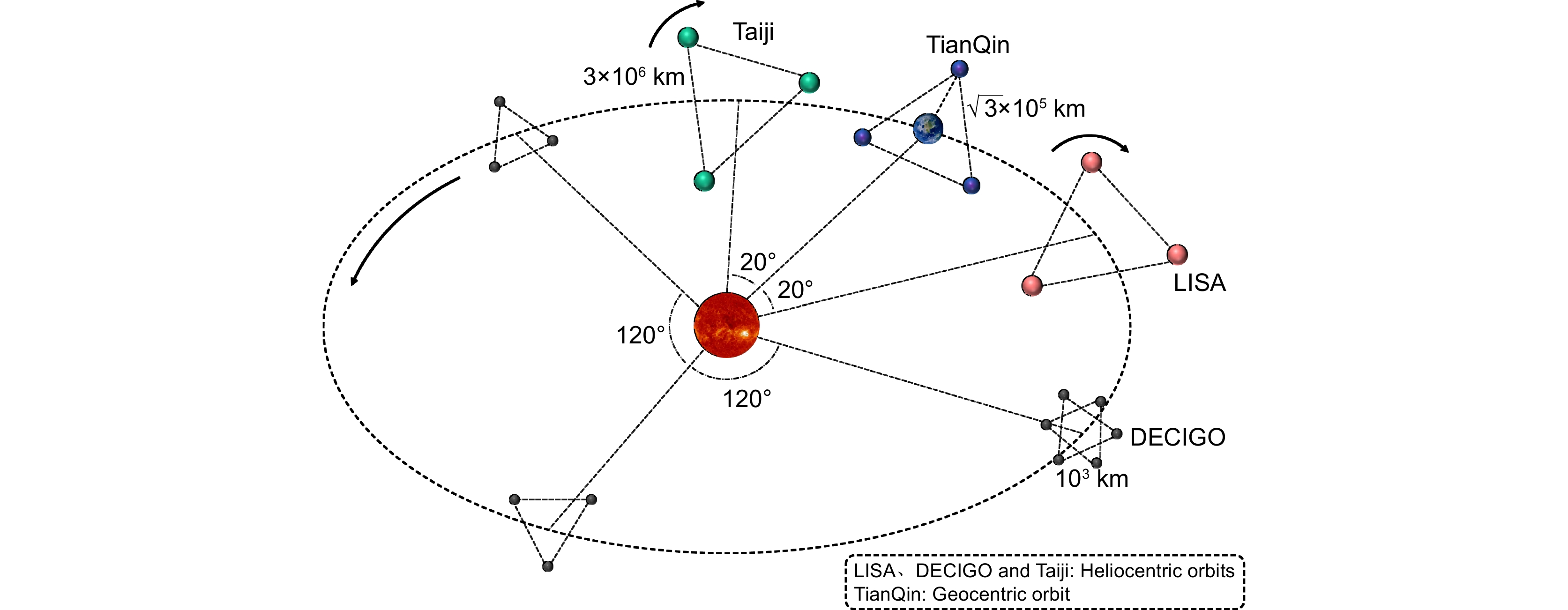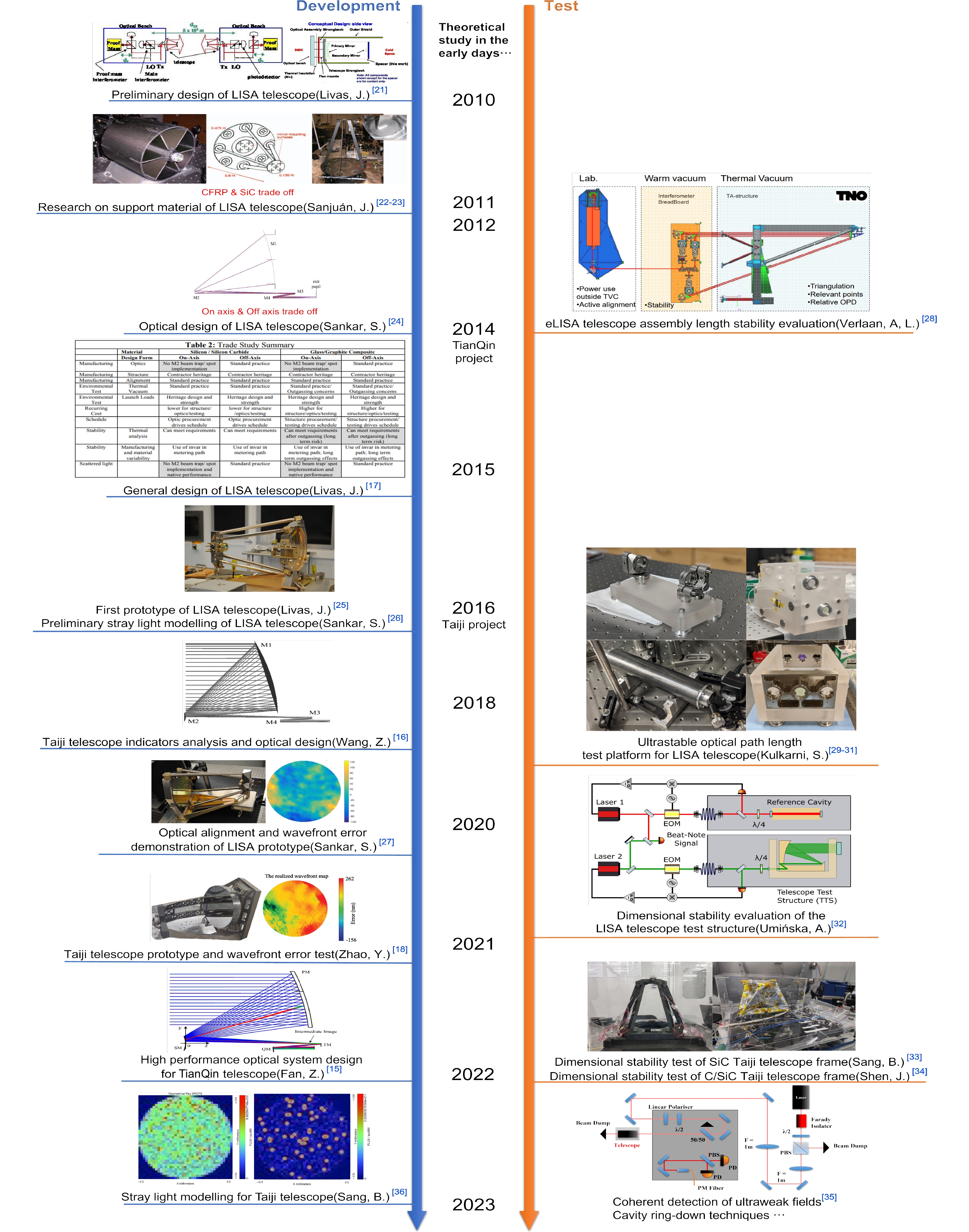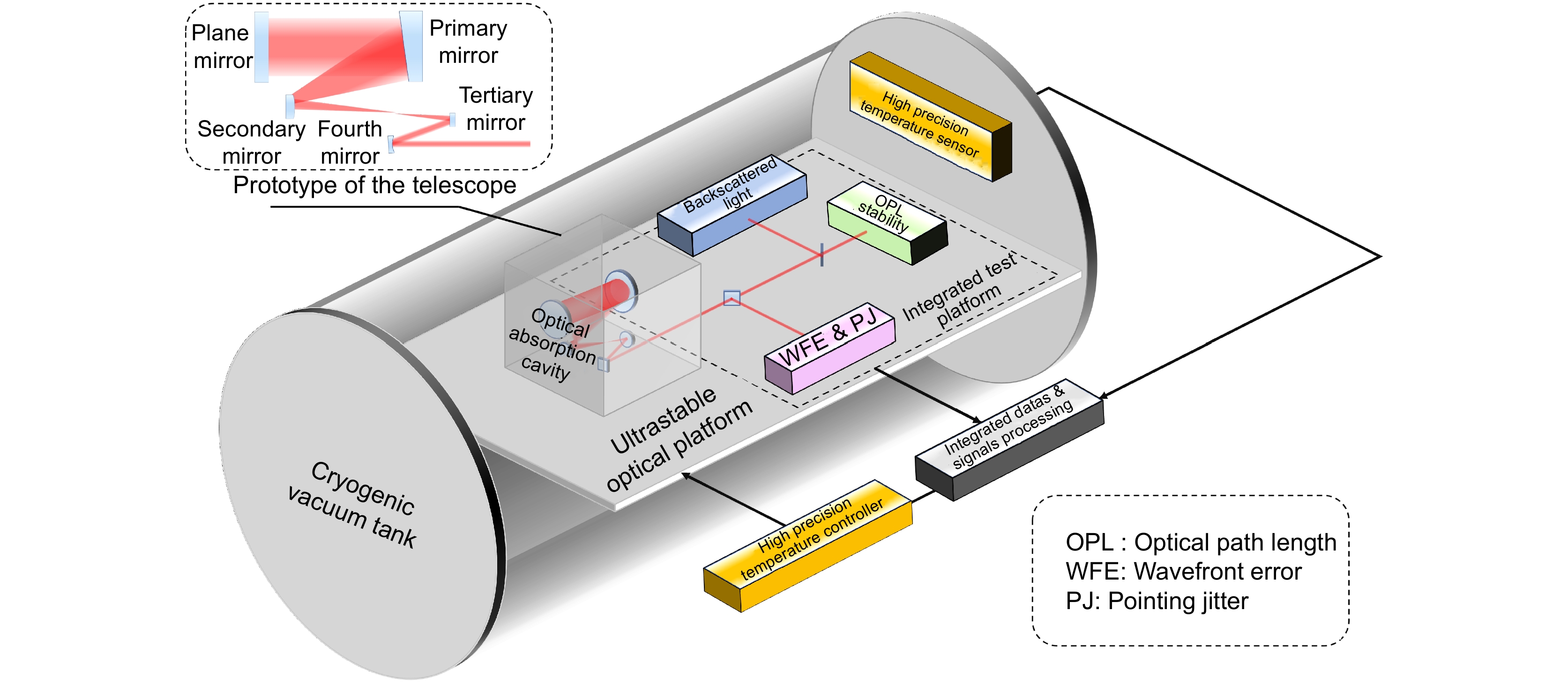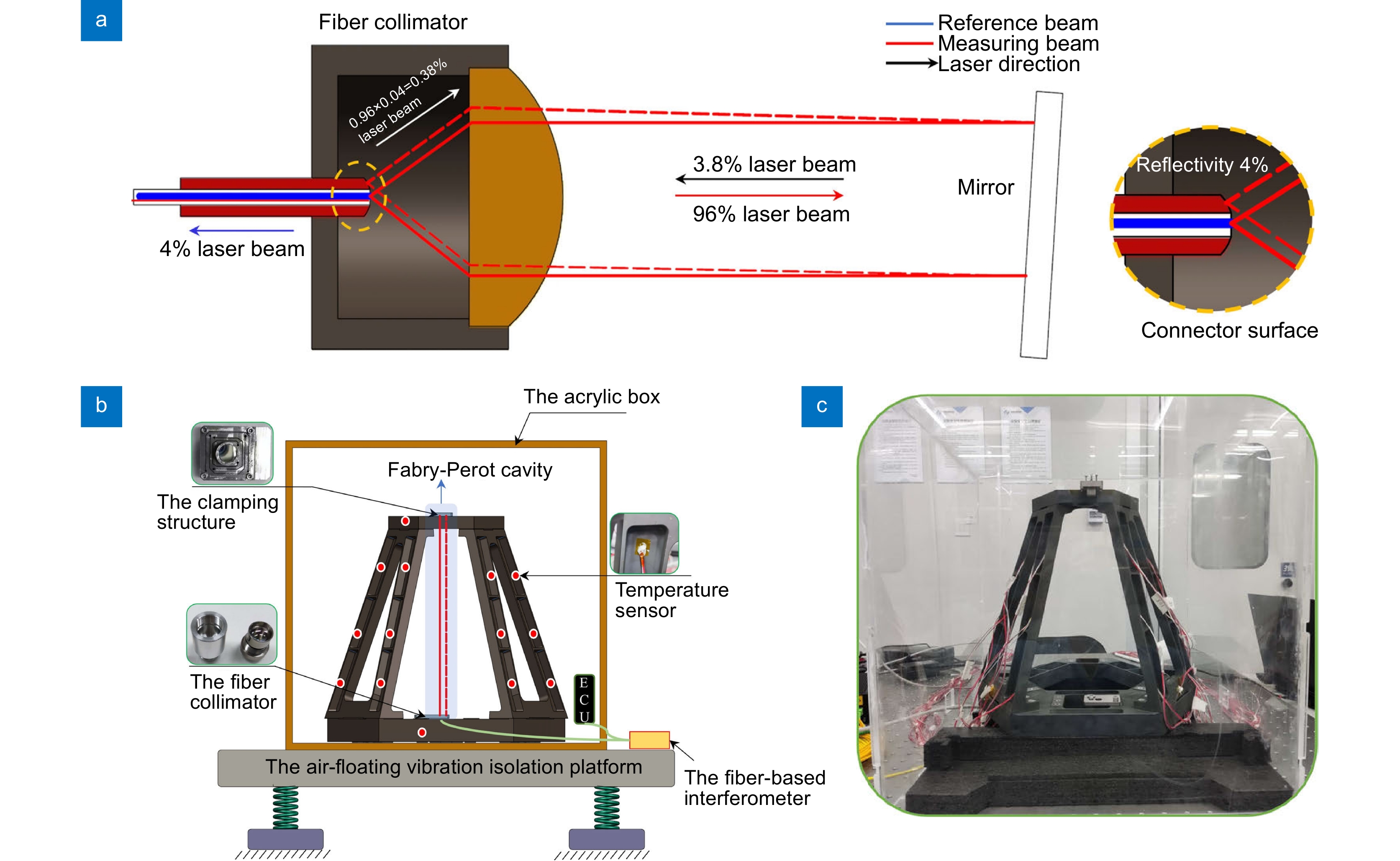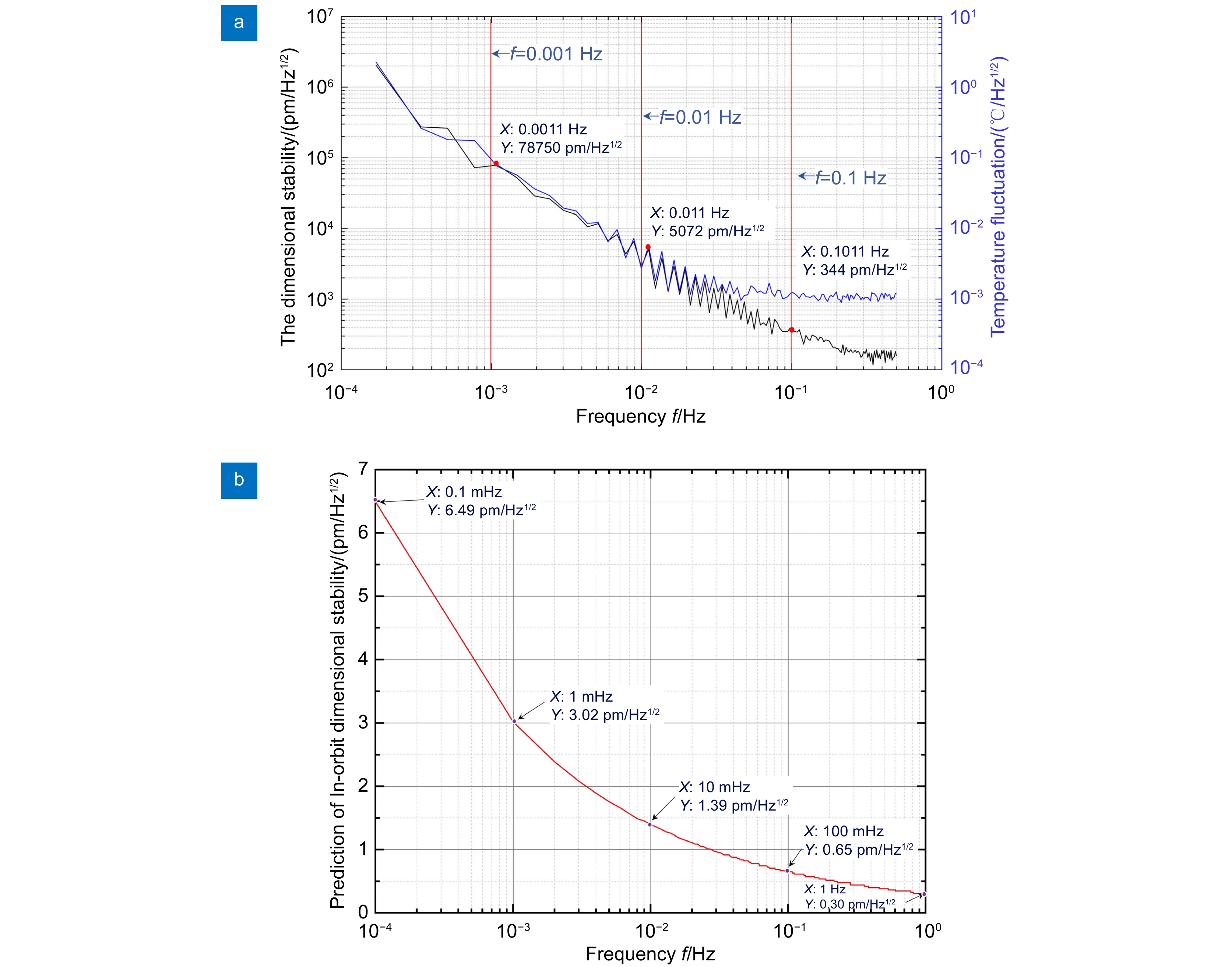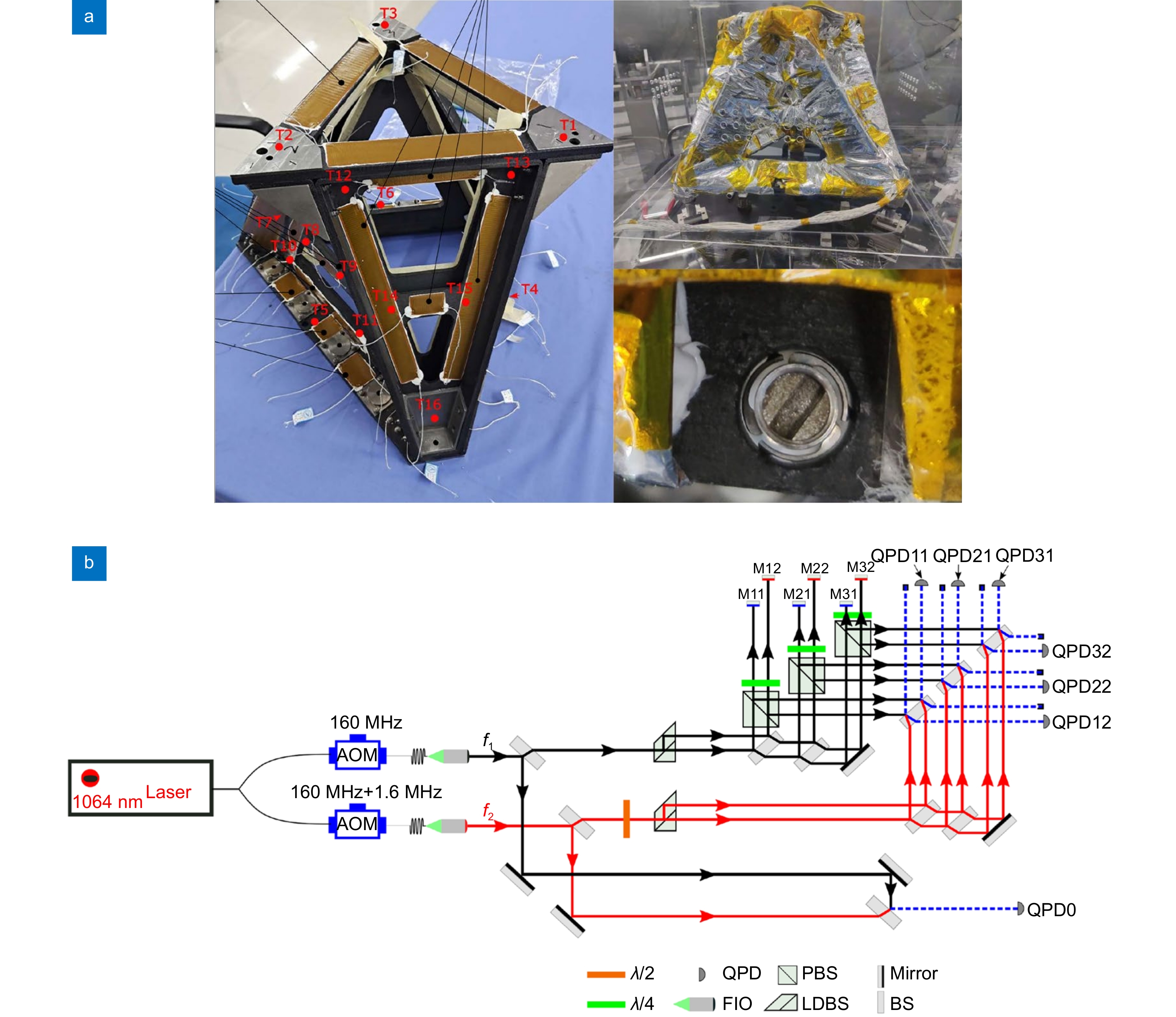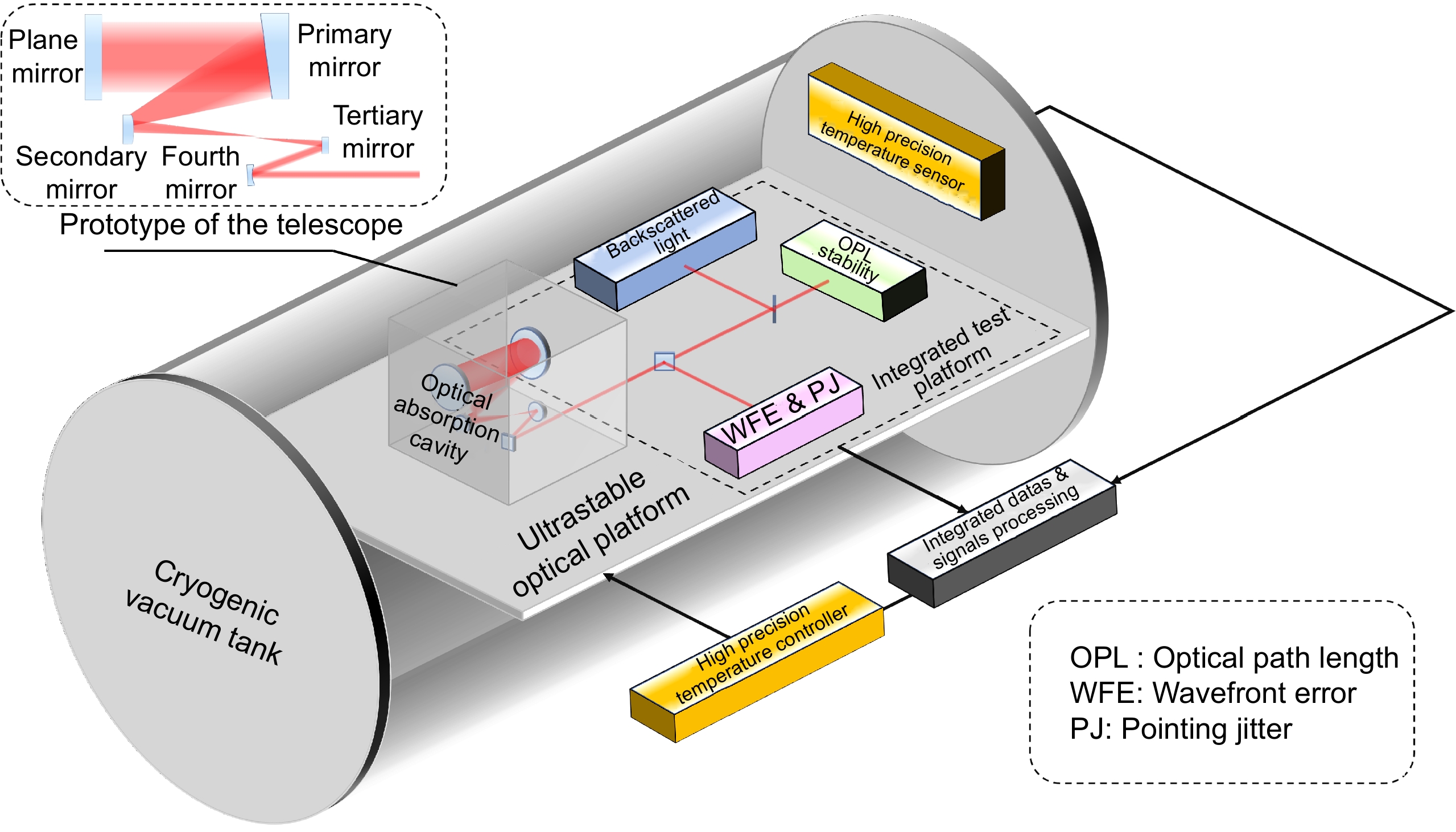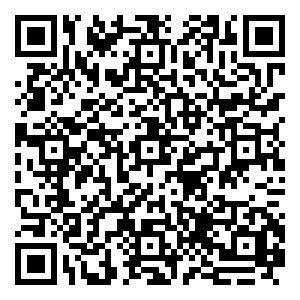Progress in the research of testing and evaluation techniques for spaceborne gravitational wave telescopes
-
摘要
在空间引力波探测任务中,星载望远镜承担太空超长干涉光路双向光束准直的重要作用。空间引力波探测对星载望远镜提出了pm级光程稳定性和低于10−10级后向杂散光水平的极高要求。超高水平指标要求超过了当前测试技术的精度极限,因此,针对星载望远镜发展测试与评估技术并开展系统超高精度测试是空间引力波探测计划成功的重要前提。本文在概述国内外在研的空间引力波探测星载望远镜研制情况的基础上,重点围绕星载望远镜的核心技术指标——光程稳定性和后向杂散光,介绍了在研望远镜的测试技术发展现状和已经取得的部分测试成果,以及各研究单位进一步的测试计划,为我国的空间引力波探测的星载望远镜测试与评估技术发展提供参考。
Abstract
Spaceborne telescopes for gravitational wave detection crucially collimate bidirectional beams in ultra-long interferometric optical paths. The faint optical path changes due to gravitational waves demand pm-level optical path length stability and below 10−10 level backscattered light in the telescopes. The ultra-high-level specifications requirements are out of state-of-the-art testing techniques. The development of testing and evaluation techniques for spaceborne telescopes is a crucial prerequisite for the success of the space gravitational wave detection program. This paper overviews the development of spaceborne gravitational wave detection telescopes, focusing on the optical path length stability and backscattered light testing status, results, and further plans, providing reference in the testing and evaluation of Chinese spaceborne gravitational wave detection telescopes.
-
Overview
Overview: Gravitational waves are spacetime oscillations radiated outward by accelerating mass objects. Significant astronomical events in the universe, such as the merging of massive black holes, emit stronger gravitational waves. Detecting gravitational waves allows for a deeper study of the laws governing celestial bodies and the origins of the universe, making accurate detection crucial. Gravitational wave detection technology utilizes Michelson interferometers to convert the extremely faint spacetime fluctuations caused by gravitational waves into measurable changes in optical path length. Recently, ground-based large Michelson interferometers have achieved direct detection of high-frequency gravitational waves. However, the detection of low-frequency gravitational waves, which is equally important, is not feasible on the ground due to arm length and ground noise issues. This necessitates the construction of ultra-large Michelson interferometers in space for low-frequency gravitational wave detection. Spaceborne gravitational wave detection telescopes play a vital role in collimating bidirectional beams in ultra-long interferometric optical paths in space. The extremely subtle changes in optical path caused by gravitational waves impose high demands for pm-level optical path length stability and below 10−10 level backscattered light in these telescopes. The ultra-high level index requirements exceed the precision limits of current ground testing techniques for telescopes. To ensure that spaceborne telescopes maintain their ultra-high design performance in the orbital environment, developing testing and evaluation techniques for these key indicators is a crucial prerequisite for the success of the space gravitational wave detection program. This paper provides an overview of the development of spaceborne gravitational wave detection telescopes, both domestically and internationally. It focuses on the current status and some test results of optical path length stability and backscattered light testing of telescopes under development, as well as further testing plans, providing a reference for the testing and evaluation of Chinese space gravitational wave detection space-borne telescopes.
-

-
图 9 Sang等基于光纤干涉仪的太极望远镜SiC框架稳定性测试装置。(a)光纤干涉仪位移测量原理;(b)测试平台示意图;(c)测试平台实物图[33]
Figure 9. Stability test of SiC frame of Taiji telescope based on fiber interferometer by Sang et al. (a) Principle of stability testing with fiber optic interferometer; (b) Schematic of the frame stability test platform; (c)Test platform pictures[33]
望远镜 口径 光程稳定性要求 杂散光要求 波前误差 指向偏差 LISA 30 cm $1 \;\mathrm{pm} / \mathrm{Hz}^{1 / 2} \times \displaystyle\sqrt {1 + { {\left( {\frac{ {3\;{\rm{m} }{\rm{H} }{\rm{z} } } }{f} } \right)}^4} }$ <10−10 <λ/30 10 nrad/Hz1/2 天琴 22 cm $\text{1}\;\text{pm/}{\text{Hz} }^{\text{1/2} }{@0.1\;{\rm{mHz}}-1\;{\rm{Hz}}}$ <10−10 <λ/30 — 太极 20 cm $\text{1}\;\text{pm}\text{/}{\text{Hz} }^{\text{1/2} }\text{×}\displaystyle\sqrt{\text{1+}{\left(\frac{\text{3}\;\text{mHz} }{ {f} }\right)}^{\text{4} } }$ <10−10 <λ/30 — 表 2 CFRP望远镜组件结构热机械要求与测试性能[47]
Table 2. CFRP telescope assembly structure thermo-mechanical requirements and tested performances[47]
Performance Requirement 1st test 2nd test 2nd test re-run CTE over 100 K/(1/K) <10−7 9.8×10−8 5.7×10−8 6.9×10−8 M1-M2 Longitudinal displacement dz/μm <5 −7.6 −8.5 −7.4 M1-M2 Lateral displacement dy/μm <2 (goal) −25.7 −26.3 −26.2 M1-M2 Rotation dRx/μrad <20 134.4 −57.3 −47.2 -
参考文献
[1] The eLISA Consortium. The gravitational universe[Z]. arXiv: 1305.5720, 2013. https://doi.org/10.48550/arXiv.1305.5720.
[2] Hogan C J. Gravitational wave sources from new physics[J]. AIP Conf Proc, 2006, 873(1): 30−40. doi: 10.1063/1.2405019
[3] Amaro-Seoane P, Gair J R, Freitag M, et al. Intermediate and extreme mass-ratio inspirals—astrophysics, science applications and detection using LISA[J]. Class Quantum Grav, 2007, 24(17): R113−R169. doi: 10.1088/0264-9381/24/17/R01
[4] 程景全, 杨德华. 引力波和引力波望远镜的发展[J]. 天文学进展, 2005, 23(3): 195−204.
Cheng J Q, Yang D H. Progress in gravitational wave detection[J]. Progr Astron, 2005, 23(3): 195−204.
[5] Abramovici A, Althouse W E, Drever R W P, et al. LIGO: The laser interferometer gravitational-wave observatory[J]. Science, 1992, 256(5055): 325−333. doi: 10.1126/science.256.5055.325
[6] The LIGO Scientific Collaboration, Aasi J, Abbott B P, et al. Advanced LIGO[J]. Class Quantum Grav, 2015, 32(7): 074001. doi: 10.1088/0264-9381/32/7/074001
[7] Acernese F, Agathos M, Agatsuma K, et al. Advanced Virgo: a second-generation interferometric gravitational wave detector[J]. Class Quantum Grav, 2014, 32(2): 024001. doi: 10.1088/0264-9381/32/2/024001
[8] Wanner G. Complex optical systems in space: numerical modelling of the heterodyne interferometry of LISA Pathfinder and LISA[D]. Hannover: Gottfried Wilhelm Leibniz Universität, 2010: 1–106. https://doi.org/10.15488/7550.
[9] Jennrich O. LISA technology and instrumentation[J]. Class Quantum Grav, 2009, 26(15): 153001. doi: 10.1088/0264-9381/26/15/153001
[10] Bayle J B, Bonga B, Caprini C, et al. Overview and progress on the Laser Interferometer Space Antenna mission[J]. Nat Astron, 2022, 6(12): 1334−1338. doi: 10.1038/s41550-022-01847-0
[11] Kawamura S, Ando M, Seto N, et al. Current status of space gravitational wave antenna DECIGO and B-DECIGO[J]. Progr Theoret Exp Phys, 2021, 2021(5): 05A105. doi: 10.1093/ptep/ptab019
[12] Luo J, Chen L S, Duan H Z, et al. TianQin: a space-borne gravitational wave detector[J]. Class Quantum Grav, 2016, 33(3): 035010. doi: 10.1088/0264-9381/33/3/035010
[13] Luo Z R, Guo Z K, Jin G, et al. A brief analysis to Taiji: Science and technology[J]. Results Phys, 2020, 16: 102918. doi: 10.1016/j.rinp.2019.102918
[14] Sanz I E, Heske A, Livas J C. A telescope for LISA–the laser interferometer space antenna[J]. Adv Opt Technol, 2018, 7(6): 395−400. doi: 10.1515/aot-2018-0044
[15] Fan Z C, Zhao L J, Cao S Y, et al. High performance telescope system design for the TianQin project[J]. Class Quantum Grav, 2022, 39(19): 195017. doi: 10.1088/1361-6382/ac8b57
[16] 王智, 沙巍, 陈哲, 等. 空间引力波探测望远镜初步设计与分析[J]. 中国光学, 2018, 11(1): 132−151. doi: 10.3788/CO.20181101.0131
Wang Z, Sha W, Chen Z, et al. Preliminary design and analysis of telescope for space gravitational wave detection[J]. Chin Opt, 2018, 11(1): 132−151. doi: 10.3788/CO.20181101.0131
[17] Livas J, Sankar S. Optical telescope design study results[J]. J Phys Conf Ser, 2015, 610(1): 012029. doi: 10.1088/1742-6596/610/1/012029
[18] Zhao Y, Shen J, Fang C, et al. Far-field optical path noise coupled with the pointing jitter in the space measurement of gravitational waves[J]. Appl Opt, 2021, 60(2): 438−444. doi: 10.1364/AO.405467
[19] Xiao Q, Duan H Z, Ming M, et al. The analysis of the far-field phase and the tilt-to-length error contribution in space-based laser interferometry[J]. Class Quantum Grav, 2023, 40(6): 065009. doi: 10.1088/1361-6382/acbadc
[20] Yan H Y, Chen Q F, Wang H, et al. Scattering model for stray light calculations in laser interferometry application to TianQin science interferometer[J]. J Phys Conf Ser, 2023, 2464(1): 012008. doi: 10.1088/1742-6596/2464/1/012008
[21] Livas J, Arsenovic P, Catellucci K, et al. Preliminary LISA telescope spacer design[C]//38th COSPAR Scientific Assembly, 2010.
[22] Sanjuán J, Preston A, Korytov D, et al. Carbon fiber reinforced polymer dimensional stability investigations for use on the laser interferometer space antenna mission telescope[J]. Rev Sci Instrum, 2011, 82(12): 124501. doi: 10.1063/1.3662470
[23] Sanjuán J, Korytov D, Mueller G, et al. Note: Silicon carbide telescope dimensional stability for space-based gravitational wave detectors[J]. Rev Sci Instrum, 2012, 83(11): 116107. doi: 10.1063/1.4767247
[24] Sankar S R, Livas J C. Optical telescope design for a space-based gravitational-wave mission[J]. Proc SPIE, 2014, 9143: 914314. doi: 10.1117/12.2056824
[25] Livas J C, Sankar S R. Optical telescope system-level design considerations for a space-based gravitational wave mission[J]. Proc SPIE, 2016, 9904: 99041K. doi: 10.1117/12.2233249
[26] Sankar S, Livas J. Testing and characterization of a prototype telescope for the evolved Laser Interferometer Space Antenna (eLISA)[J]. Proc SPIE, 2016, 9904: 99045A. doi: 10.1117/12.2233075
[27] Sankar S R, Livas J. Optical alignment and wavefront error demonstration of a prototype LISA telescope[J]. Class Quantum Grav, 2020, 37(6): 065005. doi: 10.1088/1361-6382/ab6adf
[28] Verlaan A L, Hogenhuis H, Pijnenburg J, et al. LISA telescope assembly optical stability characterization for ESA[J]. Proc SPIE, 2017, 10564: 105640K.
[29] Kulkarni S, Umińska A A, Sanjuán J, et al. Characterization of dimensional stability for materials used in ultra-stable structures[J]. Proc SPIE, 2021, 11820: 1182008. doi: 10.1117/12.2594661
[30] Kulkarni S, Umińska A, Gleason J, et al. Ultrastable optical components using adjustable commercial mirror mounts anchored in a ULE spacer[J]. Appl Opt, 2020, 59(23): 6999−7003. doi: 10.1364/AO.395831
[31] Kulkarni S. Technology development for ground verification of dimensional stability of the LISA telescope[D]. Florida: University of Florida, 2022.
[32] Umińska A A, Kulkarni S, Sanjuan J, et al. Ground testing of the LISA telescope[J]. Proc SPIE, 2021, 11820: 118200I. doi: 10.1117/12.2594605
[33] Sang B L, Deng X Q, Peng B, et al. Dimensional stability ground test and in-orbit prediction of SiC telescope frame for space gravitational wave detection[J]. IEEE Access, 2022, 10: 21041−21047. doi: 10.1109/ACCESS.2022.3152490
[34] Shen J, Zhao Y, Liu H S, et al. Multi-channel thermal deformation interference measurement of the telescope supporting frame in spaceborne gravitational wave detection[J]. Microgr Sci Technol, 2022, 34(4): 59. doi: 10.1007/s12217-022-09980-1
[35] Uminska A A, Kulkarni S, Gleason J, et al. Telescope testing for the LISA mission[C]//American Physical Society April Meeting, 2020, 65: 2.
[36] Sang B L, Deng X Q, Tao W, et al. Stray light analysis and suppression of Taiji telescope for space gravitational wave detection based on phase noise requirement[J]. Appl Sci, 2023, 13(5): 2923. doi: 10.3390/app13052923
[37] Livas J, LISA Telescope Team. LISA telescope technology development program[C]//American Astronomical Society Meeting Abstracts, 2021: 151.
[38] 王小勇,白绍竣,张倩,等. 空间引力波探测望远镜研究进展[J]. 光电工程, 2023, 50(11): 230219. doi: 10.12086/oee.2023.230219
Wang X Y, Bai S J, Zhang Q, et al. Research progress of telescopes for space-based gravitational wave missions[J]. Opto-Electron Eng, 2023, 50(11): 230219. doi: 10.12086/oee.2023.230219
[39] 范纹彤, 赵宏超, 范磊, 等. 空间引力波探测望远镜系统技术初步分析[J]. 中山大学学报(自然科学版), 2021, 60(1-2): 178−185. doi: 10.13471/j.cnki.acta.snus.2020.11.02.2020B111
Fan W T, Zhao H C, Fan L, et al. Preliminary analysis of space gravitational wave detection telescope system technology[J]. Acta Sci Nat Univ Sunyat, 2021, 60(1-2): 178−185. doi: 10.13471/j.cnki.acta.snus.2020.11.02.2020B111
[40] 李博宏, 罗健, 丘敏艳, 等. 引力波探测望远镜超低热变形桁架支撑结构设计技术[J]. 光电工程, 2023, 50(11): 230155. doi: 10.12086/oee.2023.230155
Li B H, Luo J, Qiu M Y, et al. Design technology of the truss support structure of the ultra-low thermal deformation gravitational wave detection telescope[J]. Opto-Electron Eng, 2023, 50(11): 230155. doi: 10.12086/oee.2023.230155
[41] 范子超,谈昊,莫言,等. 基于离轴四反的空间引力波探测激光发射望远镜设计[J]. 光电工程, 2023, 50(11): 230194. doi: 10.12086/oee.2023.230194
Fan Z C, Tan H, Mo Y, et al. Design theory and method of off-axis four-mirror telescope for space-based gravitational-wave mission[J]. Opto-Electron Eng, 2023, 50(11): 230194. doi: 10.12086/oee.2023.230194
[42] Sasso C P, Mana G, Mottini S. Coupling of wavefront errors and jitter in the LISA interferometer: far-field propagation[J]. Class Quantum Grav, 2018, 35(18): 185013. doi: 10.1088/1361-6382/aad7f5
[43] Vinet J Y, Christensen N, Dinu-Jaeger N, et al. LISA telescope: phase noise due to pointing jitter[J]. Class Quantum Grav, 2019, 36(20): 205003. doi: 10.1088/1361-6382/ab3a16
[44] Chen Z W, Leng R K, Yan C X, et al. Analysis of telescope wavefront aberration and optical path stability in space gravitational wave detection[J]. Appl Sci, 2022, 12(24): 12697. doi: 10.3390/app122412697
[45] Zhao Y, Shen J, Fang C, et al. Tilt-to-length noise coupled by wavefront errors in the interfering beams for the space measurement of gravitational waves[J]. Opt Express, 2020, 28(17): 25545−25561. doi: 10.1364/OE.397097
[46] Sasso C P, Mana G, Mottini S. The LISA interferometer: impact of stray light on the phase of the heterodyne signal[J]. Class Quantum Grav, 2019, 36(7): 075015. doi: 10.1088/1361-6382/ab0a15
[47] Verlaan A L, Lucarelli S. Lisa telescope assembly optical stability characterization for ESA[J]. Proc SPIE, 2017, 10563: 105634C. doi: 10.1117/12.2304092
[48] Weise D, Marenaci P, Weimer P, et al. Opto-mechanical architecture of the LISA instrument[J]. Proc SPIE, 2017, 10566: 1056611. doi: 10.1117/12.2308192
[49] Jersey K, Zhang Y Q, Harley-Trochimczyk I, et al. Design, fabrication, and testing of an optical truss interferometer for the LISA telescope[J]. Proc SPIE, 2021, 11820: 118200L. doi: 10.1117/12.2594738
[50] 赵凯, 范纹彤, 海宏文, 等. 望远镜光程稳定性测量方案设计及噪声理论分析[J]. 光电工程, 2023, 50(11): 230158. doi: 10.12086/oee.2023.230158
Zhao K, Fan W T, Hai H W, et al. Design of optical path stability measurement scheme and theoretical analysis of noise in telescope[J]. Opto-Electron Eng, 2023, 50(11): 230158. doi: 10.12086/oee.2023.230158
[51] Spector A, Mueller G. Back-reflection from a Cassegrain telescope for space-based interferometric gravitational-wave detectors[J]. Class Quantum Grav, 2012, 29(20): 205005. doi: 10.1088/0264-9381/29/20/205005
[52] Sankar S R, Livas J C. Initial progress with numerical modelling of scattered light in a candidate eLISA telescope[J]. J. Phys. Conf. Ser., 2015, 610(1): 012031. doi: 10.1088/1742-6596/610/1/012031
[53] Bush Z R, Barke S, Hollis H, et al. Coherent detection of ultraweak electromagnetic fields[J]. Phys Rev D, 2019, 99(2): 022001. doi: 10.1103/PhysRevD.99.022001
[54] 张耘豪,钟哲强,张彬. 空间引力波探测系统中超光滑光学元件表面散射特性分析[J]. 光电工程, 2023, 50(11): 230222. doi: 10.12086/oee.2023.230222
Zhang Y H, Zhong Z Q, Zhang B. Analysis of surface scattering characteristics of ultra-smooth optical components in gravitational wave detection system[J]. Opto-Electron Eng, 2023, 50(11): 230222. doi: 10.12086/oee.2023.230222
[55] 徐节速, 胡中文, 徐腾, 等. 激光引力波望远镜镜面杂散光测试方法[J]. 红外与激光工程, 2019, 48(9): 913001. doi: 10.3788/IRLA201948.0913001
Xu J S, Hu Z W, Xu T, et al. Test method of stray light on mirror surface of laser gravitational wave telescope[J]. Infrar Laser Eng, 2019, 48(9): 913001. doi: 10.3788/IRLA201948.0913001
[56] 龚元, 李斌成. 连续激光光腔衰荡法精确测量高反射率[J]. 中国激光, 2006, 33(9): 1247−1250. doi: 10.3321/j.issn:0258-7025.2006.09.021
Gong Y, Li B C. Continuous-wave cavity ring-down technique for accurate measurement of high reflectivity[J]. Chin. J. Lasers, 2006, 33(9): 1247−1250. doi: 10.3321/j.issn:0258-7025.2006.09.021
[57] 李斌成, 龚元. 光腔衰荡高反射率测量技术综述[J]. 激光与光电子学进展, 2010, 47(2): 021203. doi: 10.3788/lop47.021203
Li B C, Gong Y. Review of cavity ring-down techniques for high reflectivity measurements[J]. Laser Optoelectron Progr, 2010, 47(2): 021203. doi: 10.3788/lop47.021203
-
访问统计


 E-mail Alert
E-mail Alert RSS
RSS

 下载:
下载:
